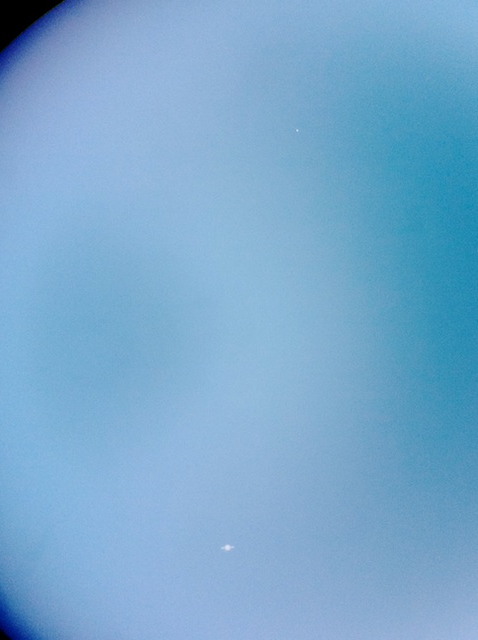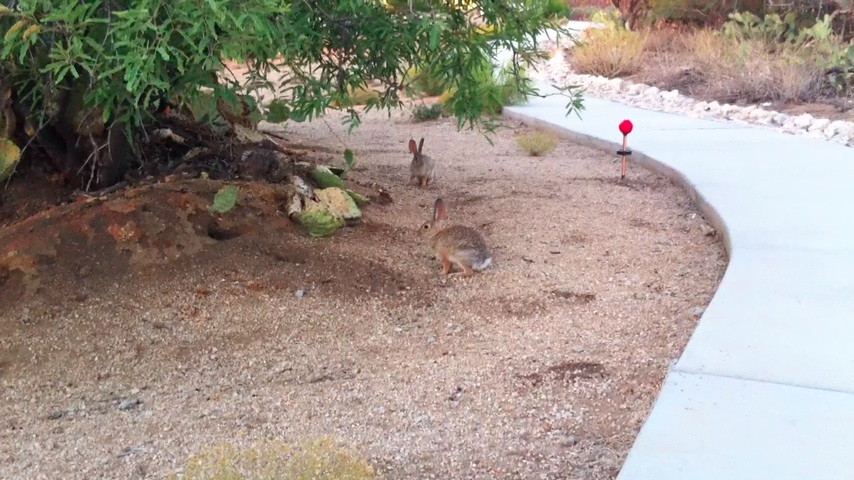
Saturn & Porrima, M55 & M75 Globular Clusters
Last updated: 23 June 2011![[Home!]](http://www.weasner.com/etx/images/mighty_etx_logo_orig-sm.jpg)
 |
Saturn & Porrima, M55 & M75 Globular ClustersLast updated: 23 June 2011 |
![[Home!]](http://www.weasner.com/etx/images/mighty_etx_logo_orig-sm.jpg) |
| Follow @mweasner | Welcome | Photos | Videos | Equipment | Links | Data |
Opened the observatory Wednesday, 22 June 2011, at 1902 MST, 100°F, under clear and calm skies. I first replaced the AA batteries in the Wireless AutoStar II. I'm still using non-rechargeable batteries pending a warranty resolution on the charger. At 1916 MST, viewed Saturn and Porrima in the 26mm eyepiece. Then set up for iPhone 4 imaging of them. This image was taken 20 minutes before sunset, afocal at 77X with the MX-1 adapter, and had a little digital zoom applied:

I noticed a couple of rabbits near the observatory. Here is a 35 second video of them taken with the iPhone 4:

I resumed Saturn viewing at 2002 MST; using the 15mm eyepiece I could see three moons: Titan, Rhea, and Tethys. I then switched to the 9.7mm and then 5.5mm eyepieces. I picked up Iapetus, well out of the plane of the other moons. Dione and Enceladus should have been visible, albeit very close to the Ring. At 2033 MST, picked up Dione in 9.7mm and 15mm eyepieces. Seeing was not very good, so could not effectively use the 5.5mm eyepiece. Dione was close to the Ring and planet, and the poor seeing made it difficult to see it so close to the planet's glare. At 2040 MST, I gave up on Enceladus. And I saw the first Kissing Bug of the night. I guess the spraying this year has been ineffective. It worked last year.
At 2100 MST, viewed M51, the Whirlpool Galaxy. The supernova that I imaged on 2 June was easily seen. Very bright.
I then viewed the M81 and M82 galaxies, both easily within the 26mm eyepiece FOV. Then it was over to M27, the Dumbbell Nebula. It was a nice view in the 26mm eyepiece. I switched to the 15mm eyepiece and could see quite a bit of detail in the nebula. Then slewed to M57, the Ring Nebula and viewed it in the 15mm and 9.7mm eyepieces. Great views in both.
Next, I spent some time using the 7x50 binoculars to view the Omega Centauri globular cluster, very low in the southwest, the sights along the Milky Way from Sagittarius to Cygnus, and finally M13, the Great Globular Cluster in Hercules. I followed that with viewing some DSOs in Sagittarius with the 8" and 26mm eyepiece: M16 (Eagle Nebula), M17 (Swan Nebula), and M20 (Trifid Nebula). Switched to the 15mm eyepiece and viewed M20 (needed averted vision to see details), M17 (lots of details easily seen), and M8 (Lagoon Nebula; nice).
At 2233 MST, switched back to the 26mm eyepiece and viewed M55, a globular cluster, low in the southeast. I then tried for M75, another globular cluster, but it was low and in a tree. Both were planned imaging targets for the night. At 2308 MST, M75 was out of the tree but both objects were still too low for imaging. So, I viewed some objects planned for imaging on another night: NGC6723, NGC6726/7, and IC4812, all in the same FOV with the 26mm eyepiece, and NGC6822 (Barnard's Galaxy, very faint).
At 2340 MST, I began setting up for D7000 DSLR prime focus imaging. First, did a focus test using the star Altair and the Bahtinov Mask. At 0000 MST, I began imaging. M55 was just barely visible in the camera viewfinder. Here is M55, 30 seconds, ISO 3200, unguided:

And M75, 30 seconds, ISO 6400, unguided:

Both images are uncropped and at the same scale. Guite a lot of size difference in the two clusters.
The eastern sky was beginning to brighten at 0015 MST from the rising moon. Closed the observatory at 0030 MST, 79°F. Terminated six Kissing Bugs during the evening.
Go to the previous report.
Return to the Cassiopeia Observatory Welcome Page.